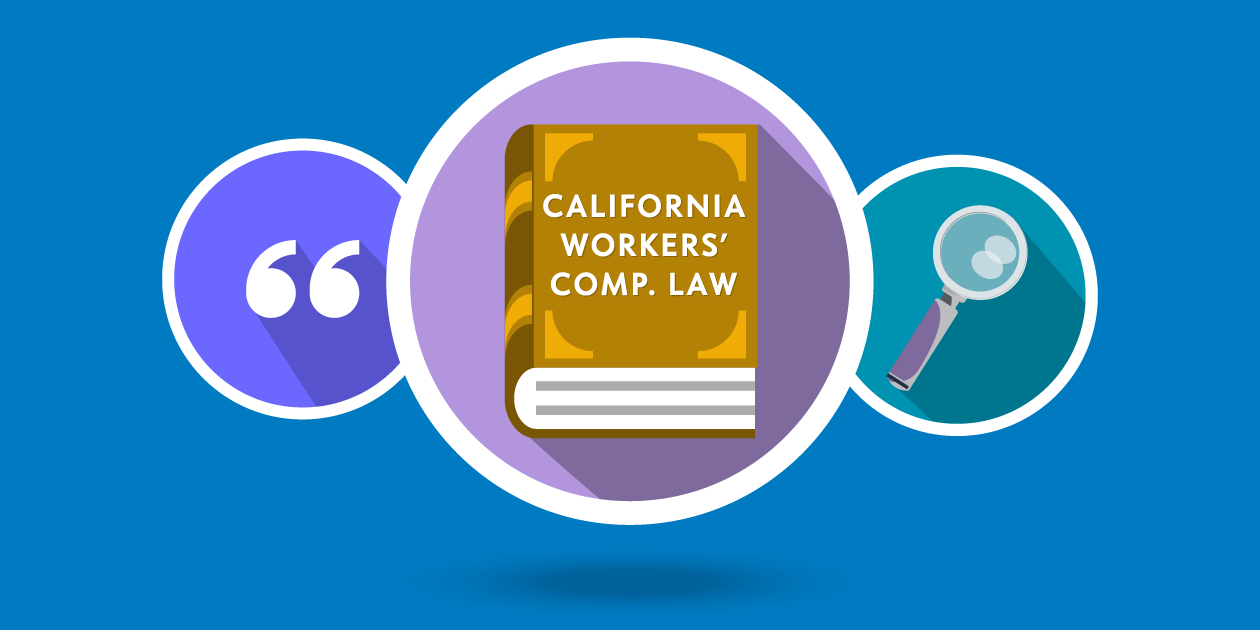Job Displacement Benefits in California Workers’ Compensation Cases
Supplemental job displacement benefits (SJDB) are an important way for California employees to get back on their feet in workers' compensation cases.

When a California employee suffers a work-related injury, the state workers’ compensation system broadly provides for several types of benefits. One of those types of benefits is called “supplemental job displacement benefits” (sometimes referred to as just “SJDB”).1
Supplemental job displacement benefits are non-transferable vouchers for employees who want to go to school or undergo vocational training so they can return to the workforce.2 They are an important tool for workers that are permanently disabled by a workplace injury, but still capable of doing some type of work.
This article takes a closer look at supplemental job displacement benefits, what they do, who is eligible for them, and how to get them.
Chapter 1
Background on California’s Workers’ Compensation System☍ Click to Copy a Link to This Chapter


To fully understand supplemental job displacement benefits, workers should first understand how this type of benefit fits into California’s workers’ compensation system as a whole.
Purpose of Workers’ Compensation Laws
The foundation of the state’s workers’ compensation system lies in the California Constitution, which sets forth the intent of the people to establish a system of workers’ compensation:
The Legislature is hereby expressly vested with plenary power, unlimited by any provision of this Constitution, to create, and enforce a complete system of workers’ compensation . . . .
This broad mandate provides the California Legislature with the power to create and enforce a complete system of workers’ compensation which strives to achieve substantial justice in all cases.3
The legislature, in turn, has adopted a somewhat complex set of rules for employers and insurance companies, as well as a series of benefits for injured workers.4 This scheme has several defining characteristics, including:
- Mandatory Insurance. Employers are required by law to maintain workers’ compensation insurance, which ensures that all employees can recover for their claims.5
- Work-Related Injuries Only. Only workplace injuries that arise in the normal course of business are compensable.6
- Exclusivity of Remedies. The workers’ compensation system is usually the exclusive way employees can legally recover for their workplace injuries.7
- No-Fault Compensation. Except in cases of serious or willful misconduct, eligible employees are entitled to benefits regardless of who was at fault for their injury.8
Although many of these characteristics favor employees, there are several aspects of California’s workers’ compensation scheme that disfavor employees.
There are, for example, limits on the kinds of lawsuits an employee can file against their employer for workplace injuries, which may also limit their available damages.9 Employees may also be required to follow certain rules and comply with short deadlines when pursuing a workers’ compensation claim.10
In essence, workers in California have given up their right to file a lawsuit against employers for their injuries. In exchange, they’ve been given a system that provides for a guaranteed, prompt, and limited recovery under the workers’ compensation scheme.11
Benefits in Workers’ Compensation Cases
Under California’s workers’ compensation system, there are five broad categories of benefits provided to injured workers:
- Medical treatment benefits,12
- Temporary disability benefits,13
- Permanent disability benefits,14
- Death benefits,15 and
- Supplemental job displacement benefits16.
Each type of benefit has a specific purpose in fulfilling the Legislature’s goal of fully compensating injured employees. The focus of this article is on the last category: supplemental job displacement benefits (sometimes called “displacement benefits” or “SJDB” for short). This type of benefit was once called “vocational rehabilitation retraining” because it can help people learn new skills.17
Supplemental job displacement benefits are intended for workers in a very specific situation—those who are permanently disabled by a workplace injury, but only partially.18 Employees in other situations are probably not entitled to supplemental job displacement benefits, and for good reason.
Workers who are temporarily disabled, for example, are not eligible for supplemental job displacement benefits because they are expected to return to their regular jobs once they have recovered.19
Likewise, employees who are permanently and totally disabled are ineligible for supplemental job displacement benefits, because they will not return to work.20 Put simply, the state does not require employers to provide work-related training to employees who will never be able to work again.
However, when workers suffer a permanently-disabling injury at the workplace, but they can still do some work, they are expected to eventually return to work.21 Thus, they are often eligible for a supplemental job displacement voucher to help them go to school or obtain other assistance finding a new job.
The Form Displacement Benefits Take
Employees eligible for supplemental job displacement benefits can receive a nontransferable voucher that allows them to enroll in an education-related training or skills enhancement program.22
The voucher can be used to pay for the costs of school, job placement services, tools, computers, certification, and training to gain the skills necessary to enter a new line of work.23
Chapter 2
Eligibility for Supplemental Job Displacement Benefits☍ Click to Copy a Link to This Chapter


The specific requirements employees need to meet before receiving supplemental job displacement benefits will depend on the date of the employee’s injury.
Specifically, employees injured between 2004 and 2012 are subject to a different test than employees injured on or after January 1, 2013.24 This reflects a change in the law that took effect beginning in 2013.
Although the eligibility requirements for SJDB vouchers are similar, there are a few important differences, which are worth understanding.
Recently-Injured Employees (2013—Present)
Most employees reading this article have suffered a recent work-related injury (i.e., one that occurred in the last five years).
An employee who suffers a work-related injury on or after January 1, 2013, is entitled to supplemental job displacement benefits if both of the following requirements are met:
- The injury caused a permanent partial disability;
- The employer has not offered the employee regular, modified, or alternative work that meets certain legal requirements.25
As is the case with most laws, these words have specific legal definitions. We’ll explore those in several of the next sections.
Requirements for Older Injuries (2004–2012)
Employees who were injured on or after January 1, 2004, and before January 1, 2013, are eligible for supplemental job displacement benefits if all of the following requirements are met:
- The injury causes permanent partial disability,
- The employer fails to offer the employee modified or alternative work within 30 days of the termination of the employee’s temporary disability benefits, and
- The injured employee does not return to work for the employer within 60 days of the termination of temporary disability.26
If the worker is a seasonal employee and the season ends within 60 days of the termination of the employee’s temporary disability benefits, the last requirement will be met if the injured employee does not return to work on the next available work date of the next work season.27
In general, the words used in these requirements have the same legal meaning they were given for employees injured on or after January 1, 2013. We’ll explore those words next.
“Permanent Disabilities” Defined
The first requirement is that the worker suffered a “permanent partial disability.” There are two aspects to this requirement: the disability must be both permanent and partial (rather than a total disability).28
A permanent disability is one that remains after the employee’s injury has completed healing (to the extent that it is able to heal).29
In assessing the permanence of an injury, courts look to whether the work-related medical condition has reached a “permanent and stationary” status.30 Permanent and stationary means that the injured worker has reached a point where they have improved from their injury as much as is medically possible.31
To meet this definition, the employee’s condition must be stabilized and unlikely to change substantially in the next year, regardless of the medical treatment they might receive.32
This is usually established by evidence from the worker’s treating physician.33 When a physician makes this determination, it means the worker’s condition has stabilized and no change is likely, and that an injured worker is left with some type of permanent disability.
When the treating doctor determines that the worker’s condition is permanent and stationary, the doctor must send a report to the claims administrator identifying the permanent disability, outlining the worker’s permanent limitations, and apportioning any kind of disability that resulted from something other than the work-related injury.34
“Partial Disabilities” Defined
As mentioned above, to be eligible for supplemental job displacement benefits the disability must be both permanent and partial.35 A partial disability is one that receives a rating of less than 100% permanent disability.36
Any disability that receives a rating of 100% permanent disability is considered a permanent total disability.37 There are four types of injuries that are presumptively considered to be “total” disabilities:
- The loss of both eyes or the sight in both eyes,
- The loss of both hands or the use of both hands,
- An injury resulting in a near-total paralysis, and
- An injury to the brain resulting in permanent mental incapacity.38
As can be seen by this list, a permanent total disability is extremely serious (and usually very rare). All other permanent injuries are considered “partial” disabilities.39
Of note, an injury that around the same level of seriousness as one of the total disabilities listed above may still be considered a “total” permanent disability, but those injuries are evaluated on a case-by-case basis.40
Offers of Regular, Modified, or Alternative Work
With regard to injuries occurring on or after January 1, 2013, an employer will not be liable for supplemental job displacement benefits if it offers the employee regular, modified, or alternative work and the employee rejects the job.41 The work offered by the employer must meet all of the following conditions:
- The job meets the worker’s restrictions and they can perform its essential functions;
- The job is a position that lasts at least 12 months;
- The job is within reasonable commuting distance from the employee’s home,42 and
- The employer’s offer is made no later than 60 days from the date that the claims administrator receives a report from the treating physician that the employee’s disabilities have become permanent and stationary (making the injury a “permanent partial disability”).43
Importantly, the three categories of work that the employer can offer each have a specific legal meaning:
- Regular Work. “Regular work” is the employee’s usual occupation, or the position the employee was engaged in at the time of the injury. An offer of regular work must include wages and compensation equivalent to those paid to the employee at the time of injury.44
- Modified Work. “Modified work” is regular work, but modified so that the employee has the ability to perform all the functions of the job. An offer of modified work must include wages and compensation that are at least 85% of those that were paid to the employee at the time of their injury.45
- Alternative Work. “Alternative work” is work that the employee has the ability to perform, that offers wages and compensation that are at least 85% of those that were paid to the employee at the time of their injury.46
The most common types of work offers are modified and alternative work offers, because the employee most likely cannot perform all the duties of their regular job. In those cases, the worker’s employer must decide whether they can modify the job to comply with the person’s restrictions or whether they can offer the employee an alternative job, as defined above.
If the employer offers regular, modified, or alternative work that meets these requirements, the worker is not entitled to receive supplemental job displacement benefits.47
Offers of Work for Pre-2013 Injuries
With regard to injuries occurring on or after January 1, 2004, but before January 1, 2013, an employer can avoid liability for supplemental job displacement benefits if they offer the employee modified work accommodating the employee’s work restrictions for at least 12 months and the employee does not accept the job officer.48 The phrase “modified work” has the same definition used for employees injured after January 1, 2013.
Likewise, if the employer offers the worker an alternative position that lasts at least 12 months, at wages and compensation that are within 15% of what the employee was paid at the time of the injury, and the job is located within a reasonable commuting distance, the employer doesn’t have to pay supplemental job displacement benefits if the employee turns the alternative work down.49
Modified Work vs. Alternative Work
So, what is the difference between modified and alternative work? Say that Jack works for Amazon. His job is packing and loading boxes. He injures his left arm and knee in a warehouse accident and has a permanent disability that limits the amount of weight he can lift.
If lifting boxes is a relatively small part of Jack’s job, Amazon can reassign all of the lifting tasks to someone else and offer Jack modified duty. Some examples of modified tasks might include taking inventory, supervising other employees, performing machinery maintenance, and proofreading shipping labels.
If Jack’s Amazon warehouse job duties involve mostly lifting boxes of over 10 pounds, then Amazon may not be required to modify the job. If this is the case, Amazon can offer Jack an alternative job.
For example, Jack may be given the opportunity to move from the warehouse to the office, where he can work a clerical position at 85% of the wages and compensation he received in the warehouse. This is alternative work. If Jack does not accept this alternative position, he will not be able to receive a supplemental job displacement voucher.
On the other hand, if Amazon does not offer Jack modified work or an alternative job, Jack can receive a supplemental job displacement benefit voucher that he can use for to learn another job, such as computer coding.
Chapter 3
Benefit Amounts for SDJB Vouchers☍ Click to Copy a Link to This Chapter


The amount of an employee’s supplemental job displacement benefits will depend on the date of their injury. Employees injured between 2004 and 2012 are entitled to different benefits than those injured on or after January 1, 2013, because the California Legislature modified the supplemental job displacement benefits schedules beginning on January 1, 2013.50
Benefits for Recently-Injured Employees
The distribution of supplemental job displacement benefits for recently-injured employees is simple: Employees injured on or after January 1, 2013, are entitled to a $6,000 voucher.51 This amount remains the same regardless of the severity of the injury or any other factors.
The employee must use the voucher within two years of being issued or five years from the date of injury, whichever comes later.52
Benefits for Older Injuries
Under the pre-2013 rules, the amount of the voucher depends on the severity of employee’s permanent partial disability. This is measured by a rating assessed by a physician.53 The SJDB voucher amount will be as follows:
- Up to $4,000 for permanent partial disability awards with a rating of less than 15%.54
- Up to $6,000 for permanent partial disability awards with a rating between 15% and 25%.55
- Up to $8,000 for permanent partial disability awards with a rating between 26% and 49%.56
- Up to $10,000 for permanent partial disability awards with a rating between 50% and 99%.57
Vouchers issued prior to January 1, 2013 do not expire.58
Using the SJDB Voucher
A supplemental job displacement benefit voucher can be used in several ways.
Most commonly, SJDB vouchers are used at a California public school or a school on the State of California’s Eligible Training Provider List (Opens in new window) that accepts the SJDB voucher.59 The voucher can be used to pay for things like tuition, fees, books, and other expenses required by one these schools.60
The employee can also use up to 10% of the voucher to pay for résumé preparation, the services of licensed placement agencies, or vocational or return-to-work counseling.61
For employees injured on or after January 1, 2013, the voucher can also be used to pay licensing or certification and testing fees,62 to purchase tools required by a training course,63 to purchase computer equipment of up to $1,000,64 and to reimburse up to $500 in miscellaneous expenses.65
An employee injured on or after January 1, 2013, cannot use the voucher for out-of-state educational providers. But employees injured between 2004 and 2012 can use the voucher to pay an out-of-state private provider of education-related retraining or skill enhancement, as long as the provider is approved by the appropriate state agency in a similar way to how California providers are approved.66
Return-to-Work Supplement Program
Workers injured on or after January 1, 2013, may also qualify for a related benefit—called the Return-to-Work Supplement Program (Opens in new window) (or “RTWSP” for short).67 This program was started for the purpose of making supplemental payments to workers whose permanent partial disability benefits are disproportionately low in comparison to their earnings losses.68
Workers who received a SJDB voucher may be eligible for a one-time payment of $5,000 under this program. The application for this payment must be filed within one year of the date the SJDB voucher was served on the worker.69
Employees who think they may be eligible for the RTWSP can apply online (Opens in new window), or in person at a Division of Workers Compensation district office (Opens in new window).70
Chapter 4
Settlement of Supplemental Job Displacement Benefits☍ Click to Copy a Link to This Chapter


It was once common for employers and employees to settle the workers’ right to receive the vocational rehabilitation benefit.71
On January 1, 2013, however, the law was amended to expressly prohibit settlement or reduction of the supplemental job displacement benefit for injuries occurring after that date.72
Since the 2013 amendment, workers’ compensation judges have not approved settlement of supplemental job displacement benefits unless the case involves “serious and good faith issues” that could lead to the entire defeat of the worker’s entitlement to benefits.73
Essentially, this means that workers can only settle supplemental job displacement benefits if there is an issue so significant that the worker’s claim could be denied altogether. No employee should negotiate away their supplemental displacement benefit without consultation with an attorney.
Chapter 5
Handling Claims with Multiple Injuries☍ Click to Copy a Link to This Chapter


Some workers may be entitled to more than one supplemental job displacement voucher when they are found to have sustained multiple injuries. Each injury claim is judged on its own merits in terms of an employee’s entitlement to a voucher.74
If the employee suffers multiple separate injuries and each injury meets the other criteria for the voucher, the employee may receive more than one displacement voucher.
It should be noted, however, that this argument has not been well-tested in the courts. As such, it is possible (though perhaps unlikely) that future court decisions could find that employees are only entitled to one supplemental job displacement benefit for all of their injuries.
Chapter 6
Final Thoughts☍ Click to Copy a Link to This Chapter


Being out of work due to a disability is very difficult, especially if the worker’s injury or illness results in a permanent disability. Workers should consult with their lawyer and physician to ensure they are receiving all the benefits to which they are entitled.
If the employee has exhausted their temporary disability benefits, this might include receiving the supplemental job displacement benefit.
References
Labor Code, §§ 4658.5, 4658.6, 4658.7↥
Labor Code, §§ 4658.5, 4658.6, 4658.7.↥
Cal. Const., art. XIV § 4.↥
Located at Labor Code sections 3200 through 6208.↥
Labor Code, §§ 3700, 3700.5.↥
Labor Code, § 3202 [“This division . . . shall be liberally construed by the courts with the purpose of extending their benefits for the protection of persons injured in the course of their employment.”], emphasis added; see also Labor Code, § 3208 [defining “injury” to mean “any injury or disease arising out of the employment . . . .”].↥
Labor Code, § 3601, subd. (a); Cole v. Fair Oaks Fire Protection Dist. (1987) 43 Cal.3d 148, 154 [“Section 3601 provided that where the ‘conditions of compensation exist,’ the right to recover compensation is ‘the exclusive remedy’ for injury or death of an employee against the employer or coemployee acting within the scope of employment except that an employee shall ‘in addition to the right of compensation against the employer, have a right to bring an action at law for damages against such other employee,’ when the injury is proximately caused by the willful and unprovoked ‘physical’ act of aggression of such other employee.”].↥
Cal. Const., art. XIV § 4 [noting that the system of compensation should exist “irrespective of the fault of any party”].↥
Renteria v. County of Orange (1978) 82 Cal.App.3d 833, 840 [“The existence of a noncompensable injury does not, by itself, abrogate the exclusive remedy provisions of the Workers’ Compensation Act.”].↥
See, e.g., Labor Code, § 5400 [“Except as provided by sections 5402 and 5403, no claim to recover compensation under this division shall be maintained unless within thirty days after the occurrence of the injury which is claimed to have caused the disability or death, there is served upon the employer notice in writing, signed by the person injured or someone in his behalf, or in case of the death of the person injured, by a dependent or someone in the dependent’s behalf.”].↥
S. G. Borello & Sons, Inc. v. Department of Industrial Relations (1989) 48 Cal.3d 341, 354 [noting that workers’ compensation seeks to “guarantee prompt, limited compensation for an employee’s work injuries, regardless of fault, as an inevitable cost of production”].↥
Labor Code, § 4600.↥
Labor Code § 4650(a).↥
Labor Code § 4650(b)↥
Labor Code §§ 4658.5, 4658.6, 4658.7↥
Labor Code §§ 4658.5, 4658.6, 4658.7↥
See, e.g., LeBoeuf v. Workers’ Comp. Appeals Bd. (1983) 34 Cal.3d 234, 249.↥
Cal. Code Regs., tit. 8, §§ 10133.31, 10133.56.↥
Labor Code, §§ 4650–4661.5; see Labor Code, §§ 4658.5, 4658.6, 4658.7.↥
See Labor Code, §§ 4658.5, 4658.6, 4658.7; see also Cal. Code Regs., tit. 8, § 10152 [“A disability is considered permanent when the employee has reached maximal medical improvement, meaning his or her condition is well stabilized, and unlikely to change substantially in the next year with or without medical treatment.”]; Labor Code, § 4452.5 [defining “total” disability].↥
Cal. Code Regs., tit. 8, §§ 10133.31, 10133.56.↥
Cal. Code Regs., tit. 8, § 10116.9, subd. (i) [“‘Nontransferable voucher’ means a document provided to an employee that allows the employee to enroll in education-related training or skills enhancement. The document shall include identifying information for the employee and claims administrator.”].↥
See Cal. Code Regs., tit. 8, § 10133.58 [defining the education-related retraining or skill enhancement programs available to employees receiving SJDB].↥
Compare Labor Code, § 4658.7 with Labor Code, § 4658.5.↥
Labor Code, § 4658.7; Cal. Code Regs., tit. 8, § 10133.31.↥
Labor Code, §§ 4658.5, 4658.6; Cal. Code Regs., tit. 8, § 10133.56, subd. (b).↥
Cal. Code Regs., tit. 8, § 10133.56, subd. (b)(4) [“[I]n the case of a seasonal employee, where the employee is unable to return to work within 60 days of the termination of temporary disability benefits because the work season has ended, the injured employee does not return to work on the next available work date of the next work season.”].↥
Labor Code, § 4658.7; Cal. Code Regs., tit. 8, § 10133.31.↥
Cal. Code Regs., tit. 8, § 10152 [“A disability is considered permanent when the employee has reached maximal medical improvement, meaning his or her condition is well stabilized, and unlikely to change substantially in the next year with or without medical treatment.”].↥
See, e.g., Huston v. Workers’ Comp. Appeals Bd. (1979) 95 Cal.App.3d 856, 868.↥
Cal. Code Regs., tit. 8, § 10152.↥
Cal. Code Regs., tit. 8, § 10152.↥
Cal. Code Regs., tit. 8, § 9785.↥
Cal. Code Regs., tit. 8, § 9785, subd. (h) [“When the primary treating physician determines that the employee’s condition is permanent and stationary, the physician shall, unless good cause is shown, report within 20 days from the date of examination any findings concerning the existence and extent of permanent impairment and limitations and any need for continuing and/or future medical care resulting from the injury.”].↥
Labor Code, § 4658.7; Cal. Code Regs., tit. 8, § 10133.31.↥
Labor Code, § 4452.5, subd. (b) [“‘Permanent partial disability’ means a permanent disability with a rating of less than 100 percent permanent disability.”].↥
Labor Code, § 4452.5, subd. (a) [“‘Permanent total disability’ means a permanent disability with a rating of 100 percent permanent disability only.”].↥
Labor Code, § 4662, subd. (a).↥
Labor Code, § 4452.5, subd. (b).↥
Labor Code, § 4662, subd. (b).↥
Labor Code, §§ 4658.1, 4658.7.↥
Labor Code, § 4658.7; Cal. Code Regs., tit. 8, § 10133.31.↥
Labor Code, § 4658.7, subd. (b)(1) [“The offer is made no later than 60 days after receipt by the claims administrator of the first report received from either the primary treating physician, an agreed medical evaluator, or a qualified medical evaluator, in the form created by the administrative director pursuant to subdivision (h), finding that the disability from all conditions for which compensation is claimed has become permanent and stationary and that the injury has caused permanent partial disability.”].↥
Labor Code, § 4658.1, subd. (a) [“‘Regular work’ means the employee’s usual occupation or the position in which the employee was engaged at the time of injury and that offers wages and compensation equivalent to those paid to the employee at the time of injury, and located within a reasonable commuting distance of the employee’s residence at the time of injury.”].↥
Labor Code, § 4658.1, subd. (b) [“‘Modified work’ means regular work modified so that the employee has the ability to perform all the functions of the job and that offers wages and compensation that are at least 85 percent of those paid to the employee at the time of injury, and located within a reasonable commuting distance of the employee’s residence at the time of injury.”].↥
Labor Code, § 4658.1, subd. (c) [“‘Alternative work’ means work that the employee has the ability to perform, that offers wages and compensation that are at least 85 percent of those paid to the employee at the time of injury, and that is located within reasonable commuting distance of the employee’s residence at the time of injury.”].↥
Labor Code, §§ 4658.1, 4658.7.↥
Labor Code, § 4658.6, subd. (a).↥
Labor Code, § 4658.6, subd. (b).↥
Labor Code, § 4658.7.↥
Labor Code, § 4658.7, subd. (d) [“The supplemental job displacement benefit shall be in the form of a voucher redeemable as provided in this section up to an aggregate of six thousand dollars ($6,000).”].↥
Labor Code, § 4658.7, subd. (f).↥
Labor Code, § 4663, subd. (c).↥
Labor Code, § 4658.5, subd. (b)(1).↥
Labor Code, § 4658.5, subd. (b)(2).↥
Labor Code, § 4658.5, subd. (b)(3).↥
Labor Code, § 4658.5, subd. (b)(4).↥
Contra Labor Code, § 4658.5, subd. (d).↥
Labor Code, §§ 4658.5, subd. (b), 4658.7, subd. (e)(1).↥
Labor Code, §§ 4658.5, subd. (b), 4658.7, subd. (e)(1).↥
Labor Code, §§ 4658.5, subd. (c), 4658.7, subd. (e)(3).↥
Labor Code, § 4658.7, subd. (e)(2).↥
Labor Code, § 4658.7, subd. (e)(4).↥
Labor Code, § 4658.7, subd. (e)(5).↥
Labor Code, § 4658.7, subd. (e)(6).↥
Compare Labor Code, § 4658.7, subd. (e), with Labor Code, § 4658.5; see also Cal. Div. of Workers’ Comp., Answers to frequently asked questions about supplemental job displacement benefits (SJDB): “Can I use the voucher out of state? (Opens in new window)“ (2018).↥
Labor Code, § 139.48, subd. (c); Cal. Code Regs., tit. 8, § 17302, subd. (a) [“To be eligible for the Return-to-Work Supplement, the individual must have received the Supplemental Job Displacement Benefit (SJDB) Voucher for an injury occurring on or after January 1, 2013.”].↥
Cal. Code Regs., tit. 8, § 17300, subd. (b) [“This program is intended to provide supplemental payments to workers whose permanent disability benefits are disproportionately low in comparison to their earnings loss.”].↥
Cal. Code Regs., tit. 8, § 17304, subd. (a) [“An application for the Return-to-Work Supplement must be received by the Return-to-Work Supplement Program within one year from the date the Voucher (DWC-AD Form 10133.32 (SJDB) Rev: 10/1/15, or later version) was served on the individual.”].↥
Cal. Code Regs., tit. 8, § 17305 [“An application must be submitted by electronic means through the Department of Industrial Relations web site. The Department will make access to this web site available at each Division of Workers’ Compensation Information and Assistance Office location in the state.”].↥
Thomas v. Sports Chalet (1977) 42 Cal.Comp.Cases 625 [expressly permitting settlement of this benefit].↥
Labor Code, § 4658.7, subd. (g) [“Settlement or commutation of a claim for the supplemental job displacement benefit shall not be permitted under Chapter 2 (commencing with Section 5000) or Chapter 3 (commencing with Section 5100) of Part 3.”].↥
Beltran v. Structural Steel Fabricators (2016) 81 Cal.Comp.Cases 1224, 1226 [“[W]e hold that where the parties establish there is a good faith dispute which, if resolved against applicant, would defeat his entitlement to all workers’ compensation benefits, applicant may settle his claim by a Compromise and Release Agreement that also settles his potential right to the Supplemental Job Displacement Benefits voucher.”].↥
Silva v. Liberty Mutual Ins. Co. (July 15, 2015) 2015 Cal.Wrk.Comp.P.D.LEXIS 405, *7 [finding that Labor Code section 4658.5, subdivision (b), and the related Administrative Director’s Rule 10133.56, subdivision (b)(1), are clear and unambiguous that if the requisite criteria are met, the employee “shall be eligible” for the benefit for each injury].↥